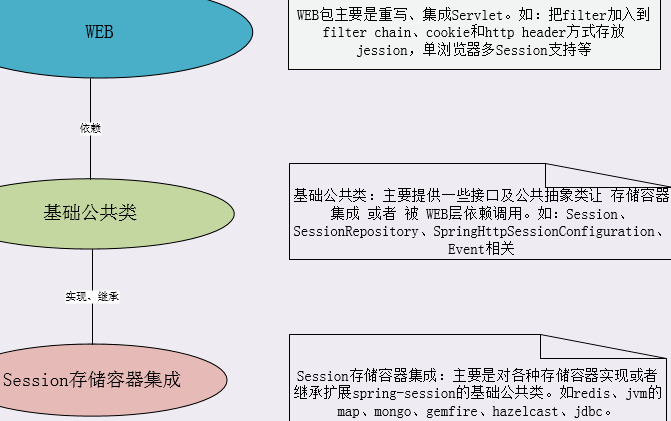之前给大家介绍了springsession是做什么的的相关内容,那么下面要接着给大家讲到的就是spring session的实现原理。
首先的话我们先通过一张图片来看一下spring session的框架分析。

接下来再来谈一下spring session实现原理的内容。
spring session重写servlet request以及redis实现存储的相关问题。
了解一下spring session无缝替换应用服务器的request的大致原理:
自定义Filter,实现doFilter方法;继承HttpServletRequestWrapper 、HttpServletResponseWrapper类,重写getSession等相关方法;在第一步的doFilter当中new 第二步自定义的request和response的类,并且将他们别传递到过滤器链;将这个filter配置到过滤器链的第一个位置上;
/** 这个类是spring-session的1.30源码,也是实现上面第一到第三步的关键类 **/
public class SessionRepositoryFilter < S extends ExpiringSession >
extends OncePerRequestFilter
{
/** session存储容器接口,redis、mongoDB、genfire等数据库都是实现该接口 **/
private final SessionRepository < S > sessionRepository;
private ServletContext servletContext;
/**
sessionID的传递方式接口。目前spring-session自带两个实现类
1.cookie方式 :CookieHttpSessionStrategy
2.http header 方式:HeaderHttpSessionStrategy
当然,我们也可以自定义其他方式。
**/
private MultiHttpSessionStrategy httpSessionStrategy = new CookieHttpSessionStrategy();
public SessionRepositoryFilter(SessionRepository < S > sessionRepository)
{
if (sessionRepository == null)
{
throw new IllegalArgumentException("sessionRepository cannot be null");
}
this.sessionRepository = sessionRepository;
}
public void setHttpSessionStrategy(HttpSessionStrategy httpSessionStrategy)
{
if (httpSessionStrategy == null)
{
throw new IllegalArgumentException("httpSessionStrategy cannot be null");
}
/**
通过前面的spring-session功能介绍,我们知道spring-session可以支持单浏览器多
session, 就是通过MultiHttpSessionStrategyAdapter来实现的。
每个浏览器拥有一个sessionID,但是这个sessionID拥有多个别名(根据浏览器的tab)。如:
别名1 sessionID
别名2 sessionID
...
而这个别名通过url来传递,这就是单浏览器多session原理了
**/
this.httpSessionStrategy = new MultiHttpSessionStrategyAdapter(
httpSessionStrategy);
}
public void setHttpSessionStrategy(MultiHttpSessionStrategy httpSessionStrategy)
{
if (httpSessionStrategy == null)
{
throw new IllegalArgumentException("httpSessionStrategy cannot be null");
}
this.httpSessionStrategy = httpSessionStrategy;
}
/**
该方法相当于重写了doFilter,只是spring-session又做了多一层封装。
在这个方法里创建自定义的 request和response,然后传递到过滤器链filterChain
**/
@Override
protected void doFilterInternal(HttpServletRequest request
, HttpServletResponse response, FilterChain filterChain)
throws ServletException, IOException
{
request.setAttribute(SESSION_REPOSITORY_ATTR, this.sessionRepository);
/**
spring-session重写的ServletRequest。这个类继承了HttpServletRequestWrapper
**/
SessionRepositoryRequestWrapper wrappedRequest = new SessionRepositoryRequestWrapper(
request, response, this.servletContext);
SessionRepositoryResponseWrapper wrappedResponse = new SessionRepositoryResponseWrapper(
wrappedRequest, response);
HttpServletRequest strategyRequest = this.httpSessionStrategy
.wrapRequest(wrappedRequest, wrappedResponse);
HttpServletResponse strategyResponse = this.httpSessionStrategy
.wrapResponse(wrappedRequest, wrappedResponse);
try
{
/**
传递自定义 request和response到链中,想象下如果
该spring-sessionFilter位于过滤器链的第一个,那么后续的Filter,
以及到达最后的控制层所获取的 request和response,是不是就是我们自定义的了?
**/
filterChain.doFilter(strategyRequest, strategyResponse);
}
finally
{
wrappedRequest.commitSession();
}
}
public void setServletContext(ServletContext servletContext)
{
this.servletContext = servletContext;
}
/**
这个就是Servlet response的重写类了
*/
private final class SessionRepositoryResponseWrapper
extends OnCommittedResponseWrapper
{
private final SessionRepositoryRequestWrapper request;
SessionRepositoryResponseWrapper(SessionRepositoryRequestWrapper request
, HttpServletResponse response)
{
super(response);
if (request == null)
{
throw new IllegalArgumentException("request cannot be null");
}
this.request = request;
}
/**
这步是持久化session到存储容器,我们可能会在一个控制层里多次调用session的操作方法
如果我们每次对session的操作都持久化到存储容器,必定会带来性能的影响。比如redis
所以我们可以在整个控制层执行完毕了,response返回信息到浏览器时,才持久化session
**/
@Override
protected void onResponseCommitted()
{
this.request.commitSession();
}
}
/**
spring-session 的request重写类,这几乎是最重要的一个重写类。里面重写了获取getSession,Session等方法以及类
*/
private final class SessionRepositoryRequestWrapper
extends HttpServletRequestWrapper
{
private Boolean requestedSessionIdValid;
private boolean requestedSessionInvalidated;
private final HttpServletResponse response;
private final ServletContext servletContext;
private SessionRepositoryRequestWrapper(HttpServletRequest request
, HttpServletResponse response, ServletContext servletContext)
{
super(request);
this.response = response;
this.servletContext = servletContext;
}
/**
* Uses the HttpSessionStrategy to write the session id to the response and
* persist the Session.
*/
private void commitSession()
{
HttpSessionWrapper wrappedSession = getCurrentSession();
if (wrappedSession == null)
{
// session失效,删除cookie或者header
if (isInvalidateClientSession())
{
SessionRepositoryFilter.this.httpSessionStrategy
.onInvalidateSession(this, this.response);
}
}
else
{
S session = wrappedSession.getSession();
SessionRepositoryFilter.this.sessionRepository.save(session);
if (!isRequestedSessionIdValid() ||
!session.getId()
.equals(getRequestedSessionId()))
{
// 把cookie或者header写回给浏览器保存
SessionRepositoryFilter.this.httpSessionStrategy.onNewSession(session
, this, this.response);
}
}
}
@SuppressWarnings("unchecked")
private HttpSessionWrapper getCurrentSession()
{
return (HttpSessionWrapper) getAttribute(CURRENT_SESSION_ATTR);
}
private void setCurrentSession(HttpSessionWrapper currentSession)
{
if (currentSession == null)
{
removeAttribute(CURRENT_SESSION_ATTR);
}
else
{
setAttribute(CURRENT_SESSION_ATTR, currentSession);
}
}
@SuppressWarnings("unused")
public String changeSessionId()
{
HttpSession session = getSession(false);
if (session == null)
{
throw new IllegalStateException(
"Cannot change session ID. There is no session associated with this request.");
}
// eagerly get session attributes in case implementation lazily loads them
Map < String, Object > attrs = new HashMap < String, Object > ();
Enumeration < String > iAttrNames = session.getAttributeNames();
while (iAttrNames.hasMoreElements())
{
String attrName = iAttrNames.nextElement();
Object value = session.getAttribute(attrName);
attrs.put(attrName, value);
}
SessionRepositoryFilter.this.sessionRepository.delete(session.getId());
HttpSessionWrapper original = getCurrentSession();
setCurrentSession(null);
HttpSessionWrapper newSession = getSession();
original.setSession(newSession.getSession());
newSession.setMaxInactiveInterval(session.getMaxInactiveInterval());
for (Map.Entry < String, Object > attr: attrs.entrySet())
{
String attrName = attr.getKey();
Object attrValue = attr.getValue();
newSession.setAttribute(attrName, attrValue);
}
return newSession.getId();
}
// 判断session是否有效
@Override
public boolean isRequestedSessionIdValid()
{
if (this.requestedSessionIdValid == null)
{
String sessionId = getRequestedSessionId();
S session = sessionId == null ? null : getSession(sessionId);
return isRequestedSessionIdValid(session);
}
return this.requestedSessionIdValid;
}
private boolean isRequestedSessionIdValid(S session)
{
if (this.requestedSessionIdValid == null)
{
this.requestedSessionIdValid = session != null;
}
return this.requestedSessionIdValid;
}
private boolean isInvalidateClientSession()
{
return getCurrentSession() == null && this.requestedSessionInvalidated;
}
private S getSession(String sessionId)
{
// 从session存储容器中根据sessionID获取session
S session = SessionRepositoryFilter.this.sessionRepository
.getSession(sessionId);
if (session == null)
{
return null;
}
// 设置sesison的最后访问时间,以防过期
session.setLastAccessedTime(System.currentTimeMillis());
return session;
}
/**
这个方法是不是很熟悉,下面还有个getSession()才更加熟悉。没错,就是在这里重新获取session方法
**/
@Override
public HttpSessionWrapper getSession(boolean create)
{
//快速获取session,可以理解为一级缓存、二级缓存这种关系
HttpSessionWrapper currentSession = getCurrentSession();
if (currentSession != null)
{
return currentSession;
}
//从httpSessionStratge里面根据cookie或者header获取sessionID
String requestedSessionId = getRequestedSessionId();
if (requestedSessionId != null &&
getAttribute(INVALID_SESSION_ID_ATTR) == null)
{
//从存储容器获取session以及设置当次初始化属性
S session = getSession(requestedSessionId);
if (session != null)
{
this.requestedSessionIdValid = true;
currentSession = new HttpSessionWrapper(session, getServletContext());
currentSession.setNew(false);
setCurrentSession(currentSession);
return currentSession;
}
else
{
if (SESSION_LOGGER.isDebugEnabled())
{
SESSION_LOGGER.debug(
"No session found by id: Caching result for getSession(false) for this HttpServletRequest.");
}
setAttribute(INVALID_SESSION_ID_ATTR, "true");
}
}
if (!create)
{
return null;
}
if (SESSION_LOGGER.isDebugEnabled())
{
SESSION_LOGGER.debug(
"A new session was created. To help you troubleshoot where the session was created we provided a StackTrace (this is not an error). You can prevent this from appearing by disabling DEBUG logging for " +
SESSION_LOGGER_NAME
, new RuntimeException(
"For debugging purposes only (not an error)"));
}
// 如果该浏览器或者其他http访问者是初次访问服务器,则为他创建个新的session
S session = SessionRepositoryFilter.this.sessionRepository.createSession();
session.setLastAccessedTime(System.currentTimeMillis());
currentSession = new HttpSessionWrapper(session, getServletContext());
setCurrentSession(currentSession);
return currentSession;
}
@Override
public ServletContext getServletContext()
{
if (this.servletContext != null)
{
return this.servletContext;
}
// Servlet 3.0+
return super.getServletContext();
}
@Override
public HttpSessionWrapper getSession()
{
return getSession(true);
}
@Override
public String getRequestedSessionId()
{
return SessionRepositoryFilter.this.httpSessionStrategy
.getRequestedSessionId(this);
}
/**
HttpSession的重写类
*/
private final class HttpSessionWrapper extends ExpiringSessionHttpSession < S >
{
HttpSessionWrapper(S session, ServletContext servletContext)
{
super(session, servletContext);
}
@Override
public void invalidate()
{
super.invalidate();
SessionRepositoryRequestWrapper.this.requestedSessionInvalidated = true;
setCurrentSession(null);
SessionRepositoryFilter.this.sessionRepository.delete(getId());
}
}
}
}Redis存储容器实现。
实现存储公共基础类->FindByIndexNameSessionRepository ,里面主要有根据indexName从redis中查找session、根据sessionID对redis中的session增删改查的方法。
redis的session存储容器,实际上的话,spring session是存在着一些缺陷的,例如,不能够做到session的过期以及销毁的实时发布事件,还有getCurrentSession当中,可能存在的一些并发问题,但是,总的来说的话,可用性还是比较的高的。
关于springsession原理的相关内容就给你介绍到这里啦,此文源于网络,仅供参考。
希望上面的文章内容可以对你的编程之路有所帮助哦!更多java编程常见问题,请继续通过奇Q工具网的内容了解并解决吧。
推荐阅读:
